Презентация teaching listening

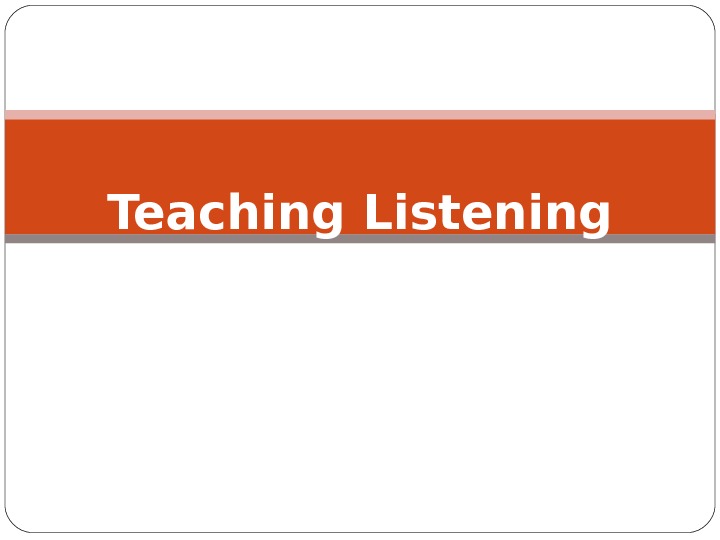
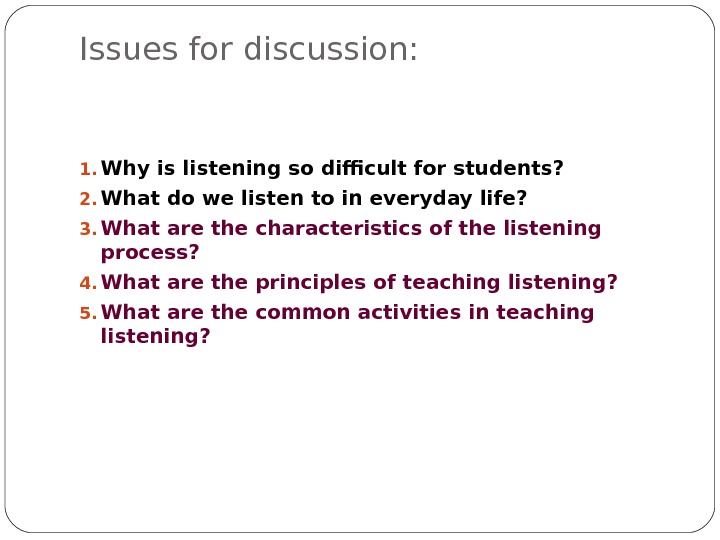
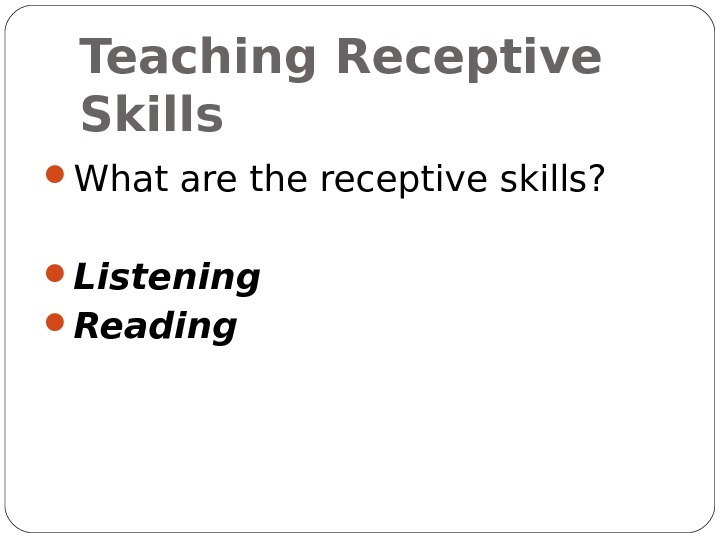
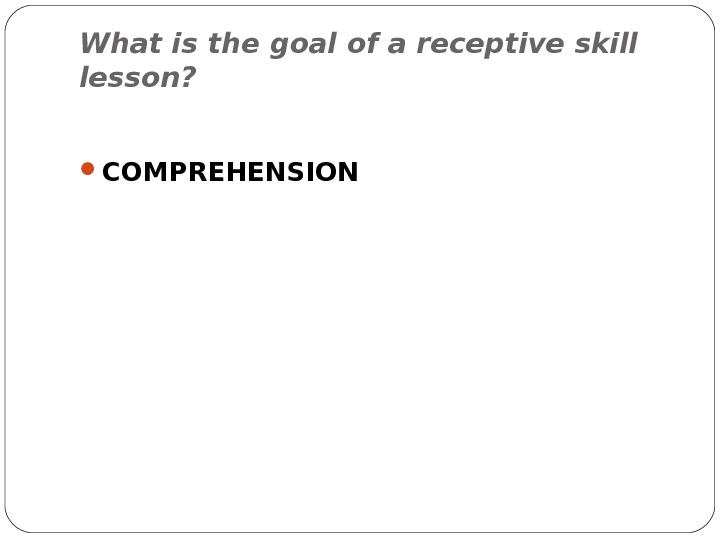

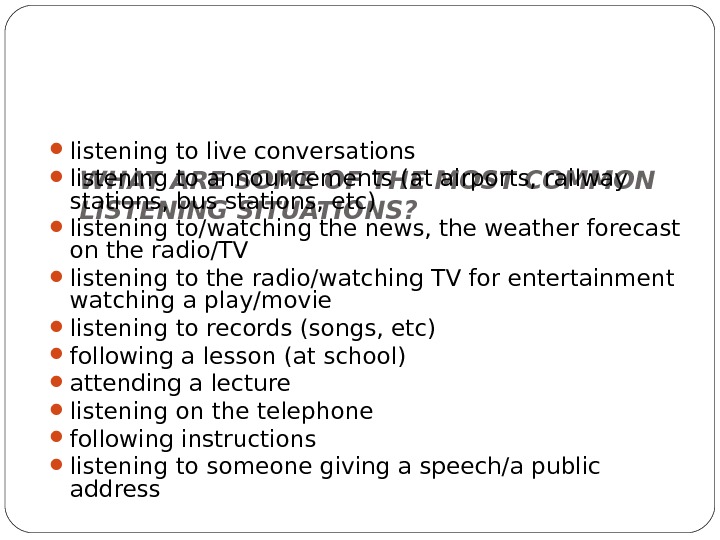
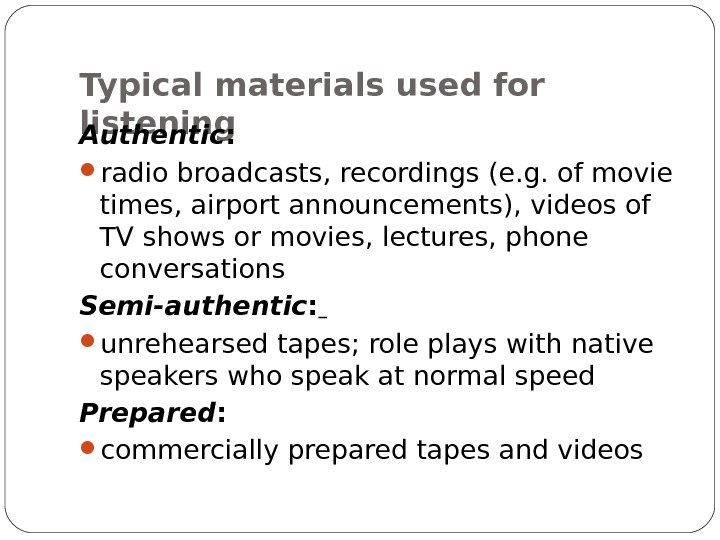
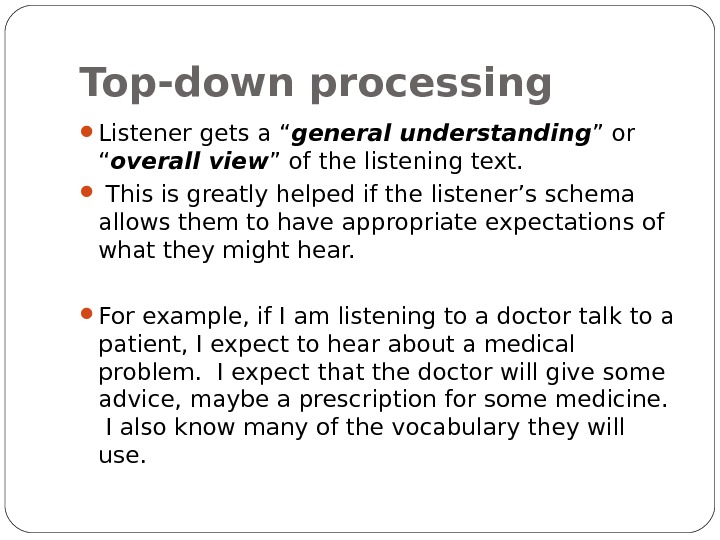
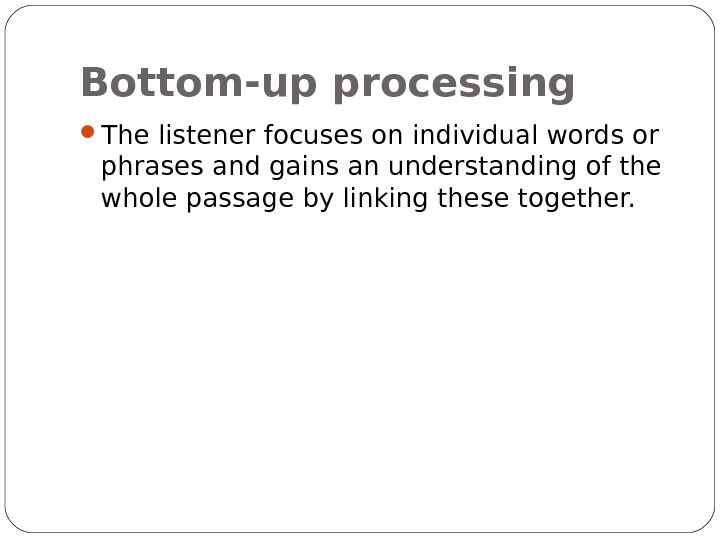


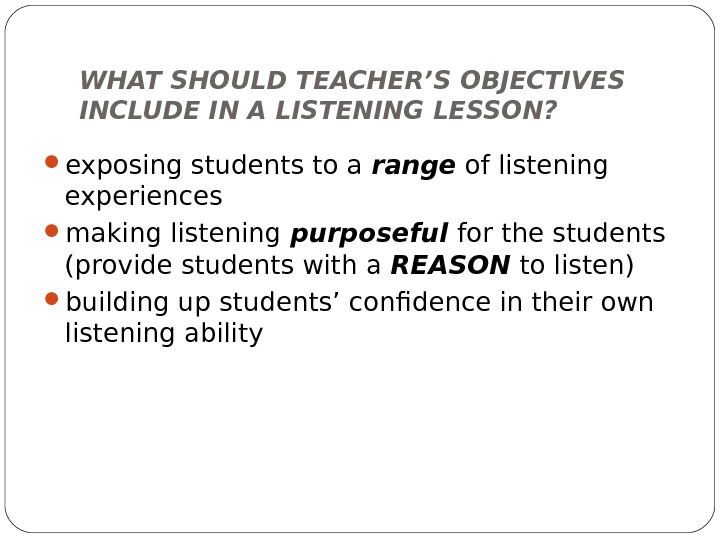
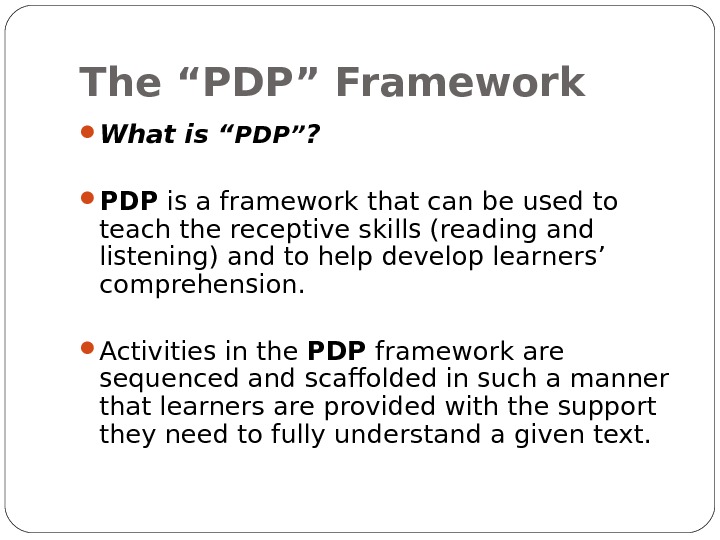
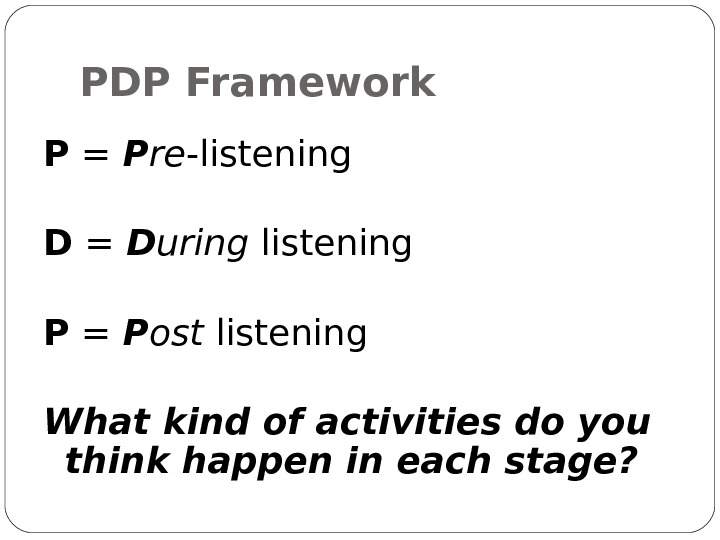
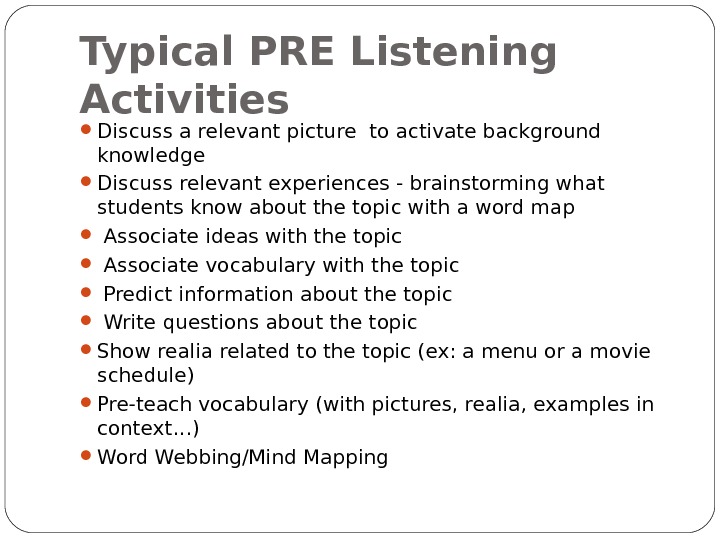
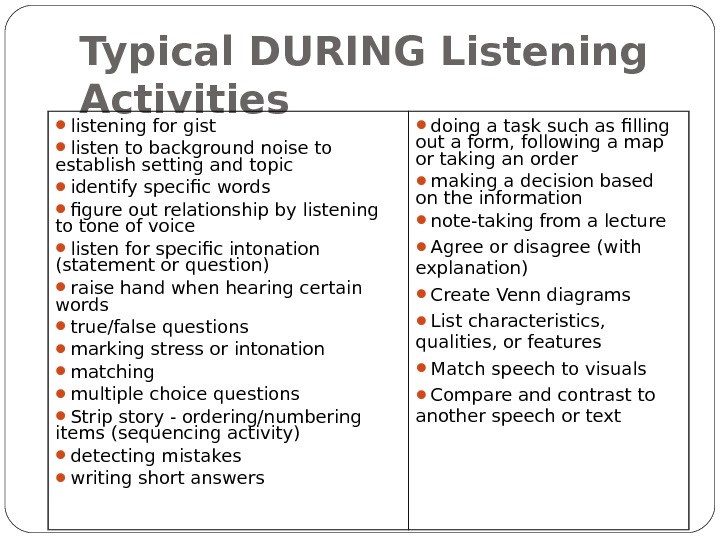
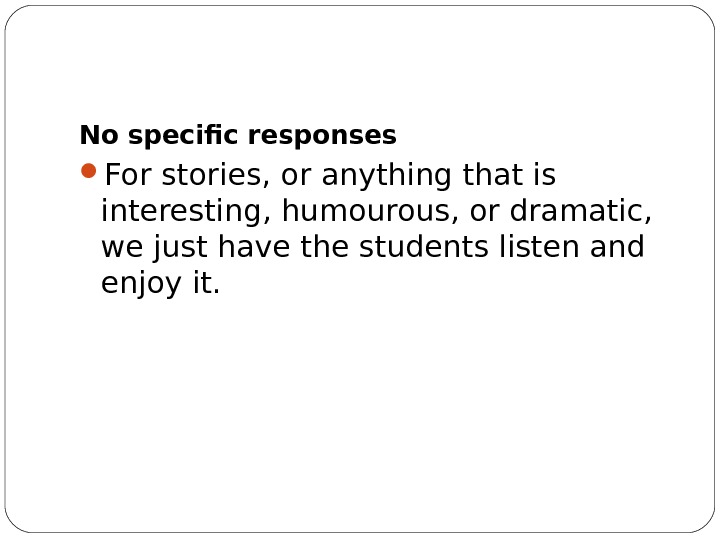
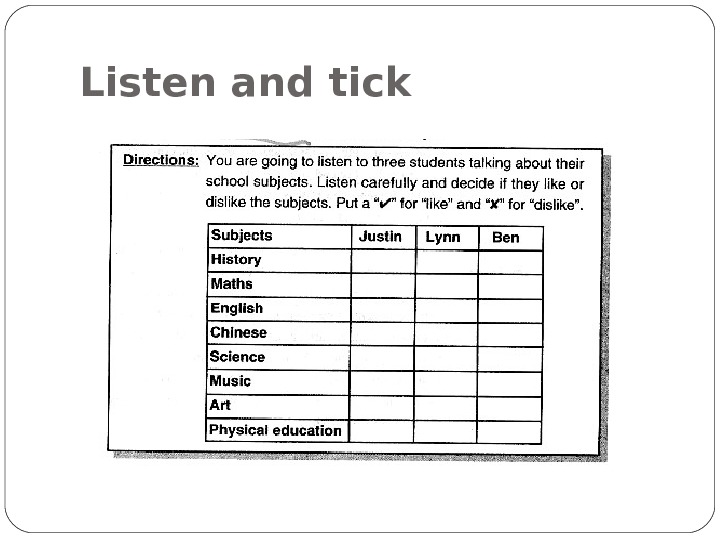
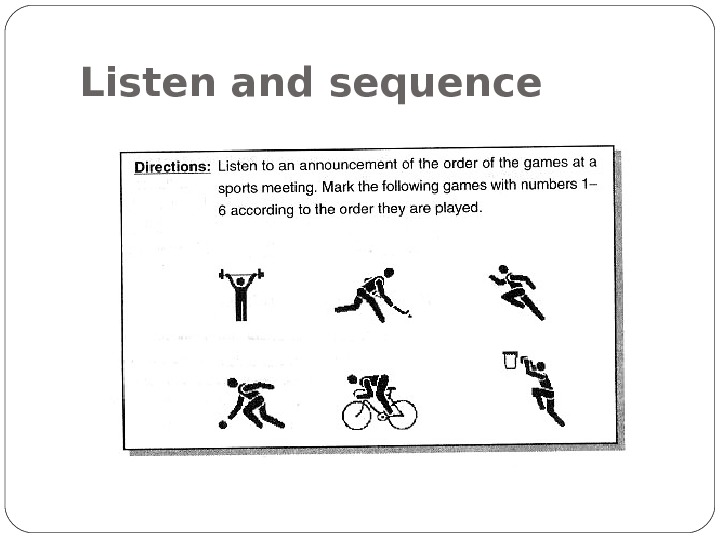
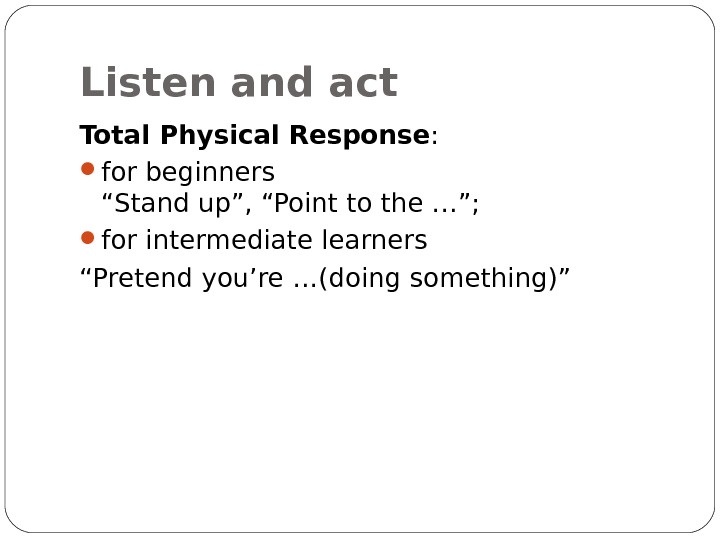

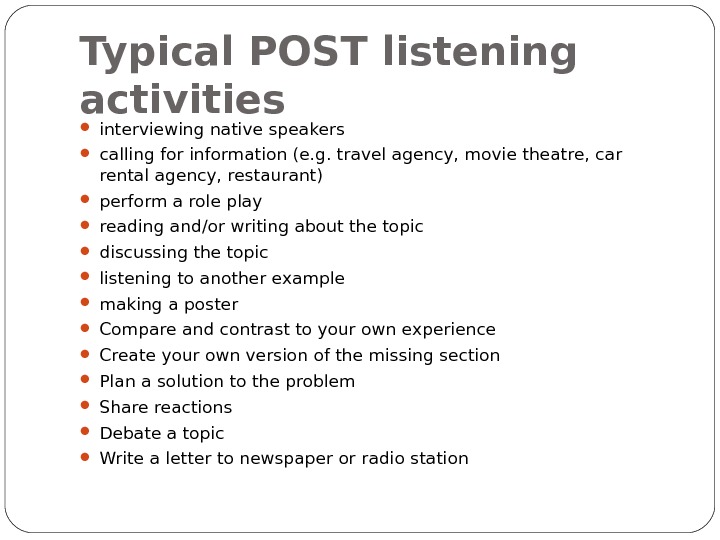
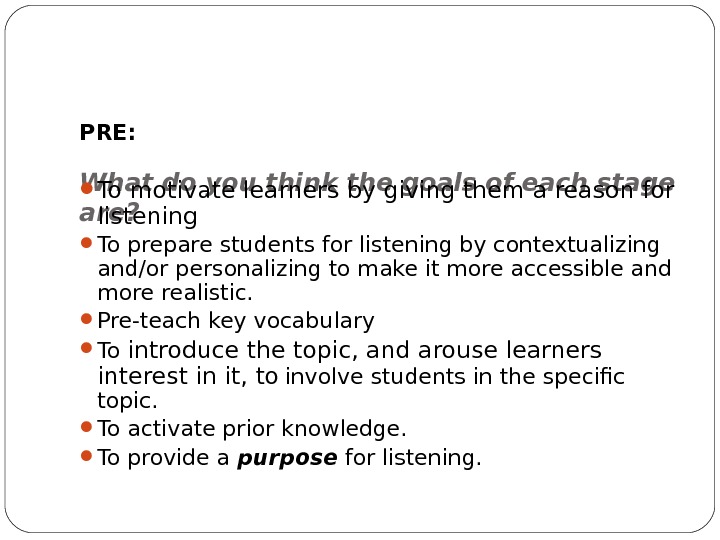
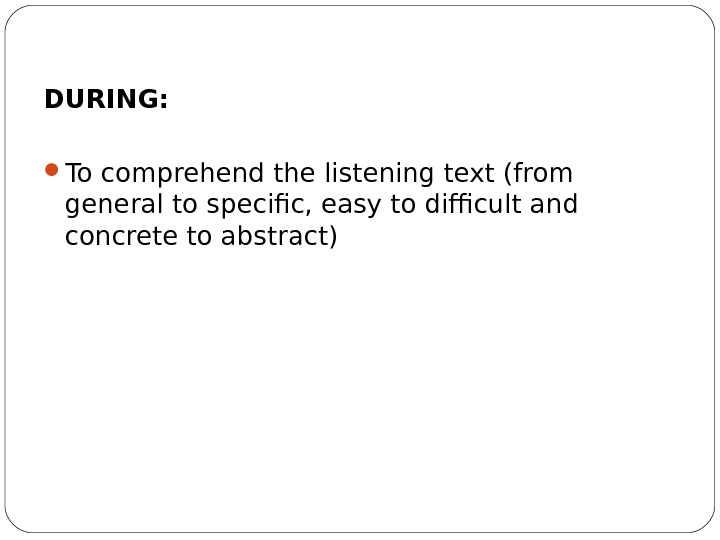
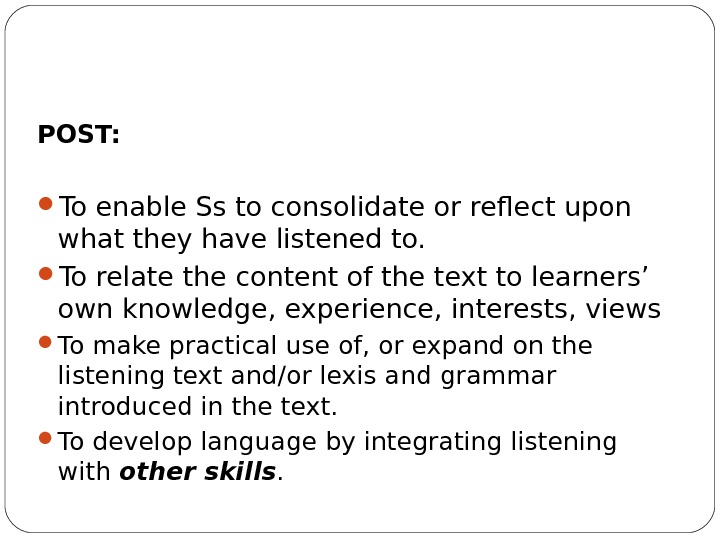
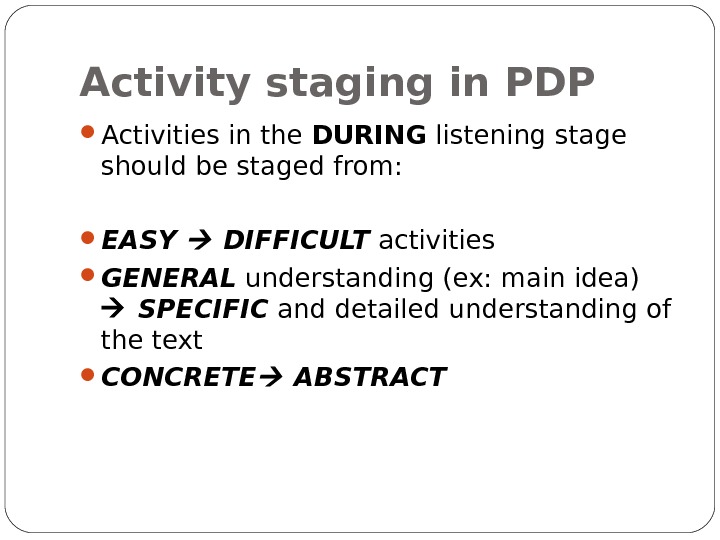

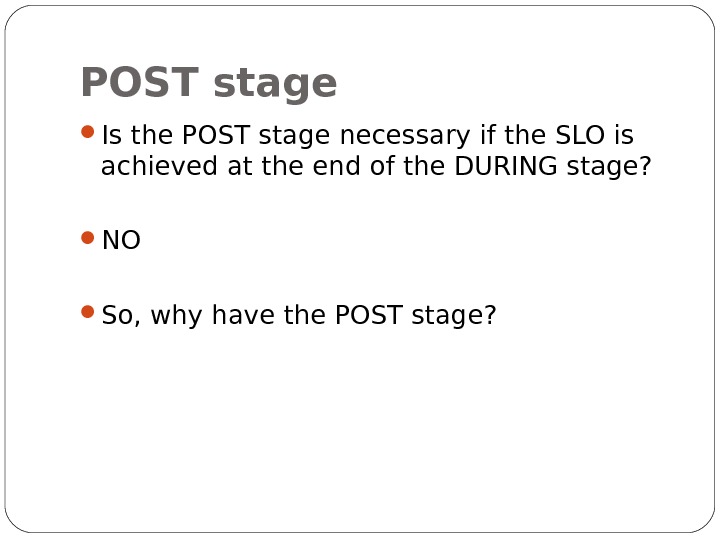
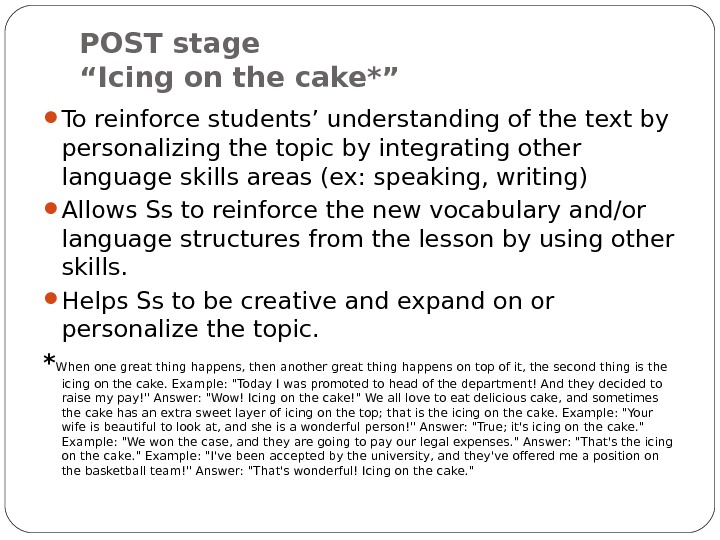
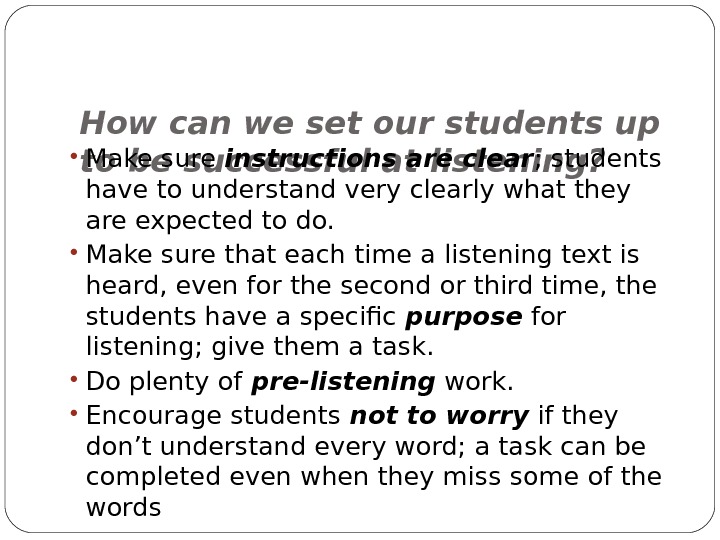
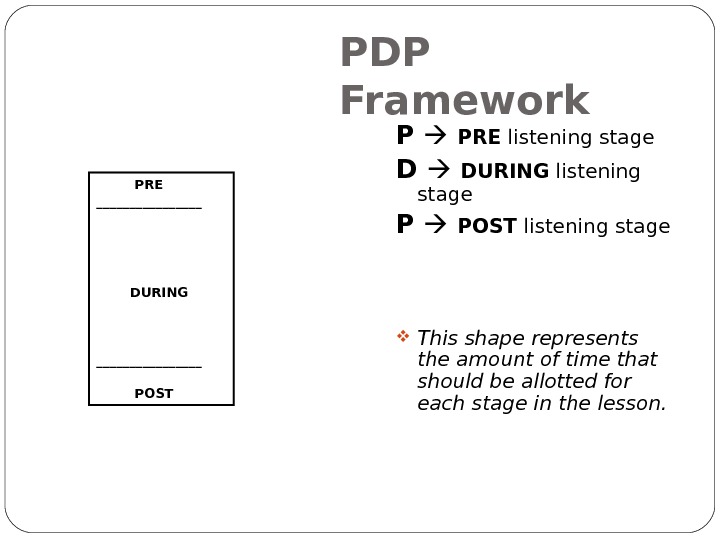
- Размер: 760 Кб
- Количество слайдов: 31
Описание презентации Презентация teaching listening по слайдам
 Teaching Listening
Teaching Listening
 Issues for discussion: 1. Why is listening so difficult for students? 2. What do we listen to in everyday life? 3. What are the characteristics of the listening process? 4. What are the principles of teaching listening? 5. What are the common activities in teaching listening?
Issues for discussion: 1. Why is listening so difficult for students? 2. What do we listen to in everyday life? 3. What are the characteristics of the listening process? 4. What are the principles of teaching listening? 5. What are the common activities in teaching listening?
 Teaching Receptive Skills What are the receptive skills? Listening Reading
Teaching Receptive Skills What are the receptive skills? Listening Reading
 What is the goal of a receptive skill lesson? COMPREHENSION
What is the goal of a receptive skill lesson? COMPREHENSION
 WHY LISTEN? to exchange information to share feelings to enjoy yourself
WHY LISTEN? to exchange information to share feelings to enjoy yourself
 WHAT ARE SOME OF THE MOST COMMON LISTENING SITUATIONS? listening to live conversations listening to announcements (at airports, railway stations, bus stations, etc) listening to/watching the news, the weather forecast on the radio/TV listening to the radio/watching TV for entertainment watching a play/movie listening to records (songs, etc) following a lesson (at school) attending a lecture listening on the telephone following instructions listening to someone giving a speech/a public address
WHAT ARE SOME OF THE MOST COMMON LISTENING SITUATIONS? listening to live conversations listening to announcements (at airports, railway stations, bus stations, etc) listening to/watching the news, the weather forecast on the radio/TV listening to the radio/watching TV for entertainment watching a play/movie listening to records (songs, etc) following a lesson (at school) attending a lecture listening on the telephone following instructions listening to someone giving a speech/a public address
 Typical materials used for listening Authentic : radio broadcasts, recordings (e. g. of movie times, airport announcements), videos of TV shows or movies, lectures, phone conversations Semi-authentic : unrehearsed tapes; role plays with native speakers who speak at normal speed Prepared : commercially prepared tapes and videos
Typical materials used for listening Authentic : radio broadcasts, recordings (e. g. of movie times, airport announcements), videos of TV shows or movies, lectures, phone conversations Semi-authentic : unrehearsed tapes; role plays with native speakers who speak at normal speed Prepared : commercially prepared tapes and videos
 Top-down processing Listener gets a “ general understanding ” or “ overall view ” of the listening text. This is greatly helped if the listener’s schema allows them to have appropriate expectations of what they might hear. For example, if I am listening to a doctor talk to a patient, I expect to hear about a medical problem. I expect that the doctor will give some advice, maybe a prescription for some medicine. I also know many of the vocabulary they will use.
Top-down processing Listener gets a “ general understanding ” or “ overall view ” of the listening text. This is greatly helped if the listener’s schema allows them to have appropriate expectations of what they might hear. For example, if I am listening to a doctor talk to a patient, I expect to hear about a medical problem. I expect that the doctor will give some advice, maybe a prescription for some medicine. I also know many of the vocabulary they will use.
 Bottom-up processing The listener focuses on individual words or phrases and gains an understanding of the whole passage by linking these together.
Bottom-up processing The listener focuses on individual words or phrases and gains an understanding of the whole passage by linking these together.
 Listening skills Identifying the topic Predicting and guessing Listening for general understanding Listening for specific or detailed information Interpreting a text/making inferences
Listening skills Identifying the topic Predicting and guessing Listening for general understanding Listening for specific or detailed information Interpreting a text/making inferences
 Extensive and Intensive Listening Extensive listening for pleasure (listening on your own; because you want to) Intensive listening for a purpose (often done with the teacher’s help; because you have to) What are some examples of why you might engage in extensive and intensive listening activities?
Extensive and Intensive Listening Extensive listening for pleasure (listening on your own; because you want to) Intensive listening for a purpose (often done with the teacher’s help; because you have to) What are some examples of why you might engage in extensive and intensive listening activities?
 WHAT SHOULD TEACHER’S OBJECTIVES INCLUDE IN A LISTENING LESSON? exposing students to a range of listening experiences making listening purposeful for the students (provide students with a REASON to listen) building up students’ confidence in their own listening ability
WHAT SHOULD TEACHER’S OBJECTIVES INCLUDE IN A LISTENING LESSON? exposing students to a range of listening experiences making listening purposeful for the students (provide students with a REASON to listen) building up students’ confidence in their own listening ability
 The “PDP” Framework What is “ PDP” ? PDP is a framework that can be used to teach the receptive skills (reading and listening) and to help develop learners’ comprehension. Activities in the PDP framework are sequenced and scaffolded in such a manner that learners are provided with the support they need to fully understand a given text.
The “PDP” Framework What is “ PDP” ? PDP is a framework that can be used to teach the receptive skills (reading and listening) and to help develop learners’ comprehension. Activities in the PDP framework are sequenced and scaffolded in such a manner that learners are provided with the support they need to fully understand a given text.
 PDP Framework P = P re -listening D = D uring listening P = P ost listening What kind of activities do you think happen in each stage?
PDP Framework P = P re -listening D = D uring listening P = P ost listening What kind of activities do you think happen in each stage?
 Typical PRE Listening Activities Discuss a relevant picture to activate background knowledge Discuss relevant experiences — brainstorming what students know about the topic with a word map Associate ideas with the topic Associate vocabulary with the topic Predict information about the topic Write questions about the topic Show realia related to the topic (ex: a menu or a movie schedule) Pre-teach vocabulary (with pictures, realia, examples in context…) Word Webbing/Mind Mapping
Typical PRE Listening Activities Discuss a relevant picture to activate background knowledge Discuss relevant experiences — brainstorming what students know about the topic with a word map Associate ideas with the topic Associate vocabulary with the topic Predict information about the topic Write questions about the topic Show realia related to the topic (ex: a menu or a movie schedule) Pre-teach vocabulary (with pictures, realia, examples in context…) Word Webbing/Mind Mapping
 Typical DURING Listening Activities listening for gist listen to background noise to establish setting and topic identify specific words figure out relationship by listening to tone of voice listen for specific intonation (statement or question) raise hand when hearing certain words true/false questions marking stress or intonation matching multiple choice questions Strip story — ordering/numbering items (sequencing activity) detecting mistakes writing short answers doing a task such as filling out a form, following a map or taking an order making a decision based on the information note-taking from a lecture Agree or disagree (with explanation) Create Venn diagrams List characteristics, qualities, or features Match speech to visuals Compare and contrast to another speech or text
Typical DURING Listening Activities listening for gist listen to background noise to establish setting and topic identify specific words figure out relationship by listening to tone of voice listen for specific intonation (statement or question) raise hand when hearing certain words true/false questions marking stress or intonation matching multiple choice questions Strip story — ordering/numbering items (sequencing activity) detecting mistakes writing short answers doing a task such as filling out a form, following a map or taking an order making a decision based on the information note-taking from a lecture Agree or disagree (with explanation) Create Venn diagrams List characteristics, qualities, or features Match speech to visuals Compare and contrast to another speech or text
 No specific responses For stories, or anything that is interesting, humourous, or dramatic, we just have the students listen and enjoy it.
No specific responses For stories, or anything that is interesting, humourous, or dramatic, we just have the students listen and enjoy it.
 Listen and tick
Listen and tick
 Listen and sequence
Listen and sequence
 Listen and act Total Physical Response : for beginners “Stand up”, “Point to the …”; for intermediate learners “ Pretend you’re …(doing something)”
Listen and act Total Physical Response : for beginners “Stand up”, “Point to the …”; for intermediate learners “ Pretend you’re …(doing something)”
 Listen and draw Listen and fill Listen and guess
Listen and draw Listen and fill Listen and guess
 Typical POST listening activities interviewing native speakers calling for information (e. g. travel agency, movie theatre, car rental agency, restaurant) perform a role play reading and/or writing about the topic discussing the topic listening to another example making a poster Compare and contrast to your own experience Create your own version of the missing section Plan a solution to the problem Share reactions Debate a topic Write a letter to newspaper or radio station
Typical POST listening activities interviewing native speakers calling for information (e. g. travel agency, movie theatre, car rental agency, restaurant) perform a role play reading and/or writing about the topic discussing the topic listening to another example making a poster Compare and contrast to your own experience Create your own version of the missing section Plan a solution to the problem Share reactions Debate a topic Write a letter to newspaper or radio station
 What do you think the goals of each stage are? PRE: To motivate learners by giving them a reason for listening To prepare students for listening by contextualizing and/or personalizing to make it more accessible and more realistic. Pre-teach key vocabulary To introduce the topic, and arouse learners interest in it , to involve students in the specific topic. To activate prior knowledge. To provide a purpose for listening.
What do you think the goals of each stage are? PRE: To motivate learners by giving them a reason for listening To prepare students for listening by contextualizing and/or personalizing to make it more accessible and more realistic. Pre-teach key vocabulary To introduce the topic, and arouse learners interest in it , to involve students in the specific topic. To activate prior knowledge. To provide a purpose for listening.
 DURING: To comprehend the listening text (from general to specific, easy to difficult and concrete to abstract)
DURING: To comprehend the listening text (from general to specific, easy to difficult and concrete to abstract)
 POST: To enable Ss to consolidate or reflect upon what they have listened to. To relate the content of the text to learners’ own knowledge, experience, interests, views To make practical use of, or expand on the listening text and/or lexis and grammar introduced in the text. To develop language by integrating listening with other skills.
POST: To enable Ss to consolidate or reflect upon what they have listened to. To relate the content of the text to learners’ own knowledge, experience, interests, views To make practical use of, or expand on the listening text and/or lexis and grammar introduced in the text. To develop language by integrating listening with other skills.
 Activity staging in PDP Activities in the DURING listening stage should be staged from: EASY DIFFICULT activities GENERAL understanding (ex: main idea) SPECIFIC and detailed understanding of the text CONCRETE ABSTRACT
Activity staging in PDP Activities in the DURING listening stage should be staged from: EASY DIFFICULT activities GENERAL understanding (ex: main idea) SPECIFIC and detailed understanding of the text CONCRETE ABSTRACT
 SLO ( Student Learning Outcome ) and PDP Where is the SLO achieved in the PDP framework? The SLO is achieved at the END of the DURING stage.
SLO ( Student Learning Outcome ) and PDP Where is the SLO achieved in the PDP framework? The SLO is achieved at the END of the DURING stage.
 POST stage Is the POST stage necessary if the SLO is achieved at the end of the DURING stage? NO So, why have the POST stage?
POST stage Is the POST stage necessary if the SLO is achieved at the end of the DURING stage? NO So, why have the POST stage?
 POST stage “Icing on the cake*” To reinforce students’ understanding of the text by personalizing the topic by integrating other language skills areas (ex: speaking, writing) Allows Ss to reinforce the new vocabulary and/or language structures from the lesson by using other skills. Helps Ss to be creative and expand on or personalize the topic. * When one great thing happens, then another great thing happens on top of it, the second thing is the icing on the cake. Example: «Today I was promoted to head of the department! And they decided to raise my pay!» Answer: «Wow! Icing on the cake!» We all love to eat delicious cake, and sometimes the cake has an extra sweet layer of icing on the top; that is the icing on the cake. Example: «Your wife is beautiful to look at, and she is a wonderful person!» Answer: «True; it’s icing on the cake. » Example: «We won the case, and they are going to pay our legal expenses. » Answer: «That’s the icing on the cake. » Example: «I’ve been accepted by the university, and they’ve offered me a position on the basketball team!» Answer: «That’s wonderful! Icing on the cake. «
POST stage “Icing on the cake*” To reinforce students’ understanding of the text by personalizing the topic by integrating other language skills areas (ex: speaking, writing) Allows Ss to reinforce the new vocabulary and/or language structures from the lesson by using other skills. Helps Ss to be creative and expand on or personalize the topic. * When one great thing happens, then another great thing happens on top of it, the second thing is the icing on the cake. Example: «Today I was promoted to head of the department! And they decided to raise my pay!» Answer: «Wow! Icing on the cake!» We all love to eat delicious cake, and sometimes the cake has an extra sweet layer of icing on the top; that is the icing on the cake. Example: «Your wife is beautiful to look at, and she is a wonderful person!» Answer: «True; it’s icing on the cake. » Example: «We won the case, and they are going to pay our legal expenses. » Answer: «That’s the icing on the cake. » Example: «I’ve been accepted by the university, and they’ve offered me a position on the basketball team!» Answer: «That’s wonderful! Icing on the cake. «
 How can we set our students up to be successful at listening? • Make sure instructions are clear ; students have to understand very clearly what they are expected to do. • Make sure that each time a listening text is heard, even for the second or third time, the students have a specific purpose for listening; give them a task. • Do plenty of pre-listening work. • Encourage students not to worry if they don’t understand every word; a task can be completed even when they miss some of the words
How can we set our students up to be successful at listening? • Make sure instructions are clear ; students have to understand very clearly what they are expected to do. • Make sure that each time a listening text is heard, even for the second or third time, the students have a specific purpose for listening; give them a task. • Do plenty of pre-listening work. • Encourage students not to worry if they don’t understand every word; a task can be completed even when they miss some of the words
 PDP Framework PRE ________ DURING ________ POST P PRE listening stage D DURING listening stage P POST listening stage This shape represents the amount of time that should be allotted for each stage in the lesson.
PDP Framework PRE ________ DURING ________ POST P PRE listening stage D DURING listening stage P POST listening stage This shape represents the amount of time that should be allotted for each stage in the lesson.

